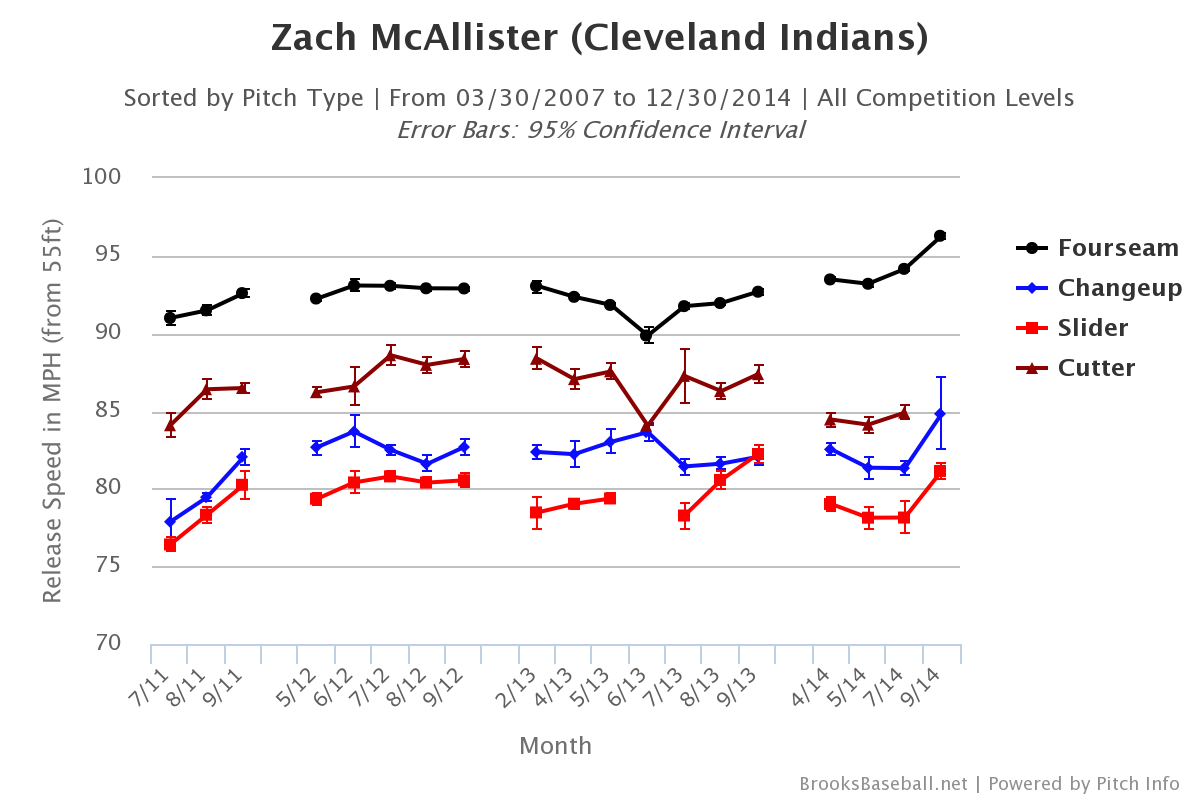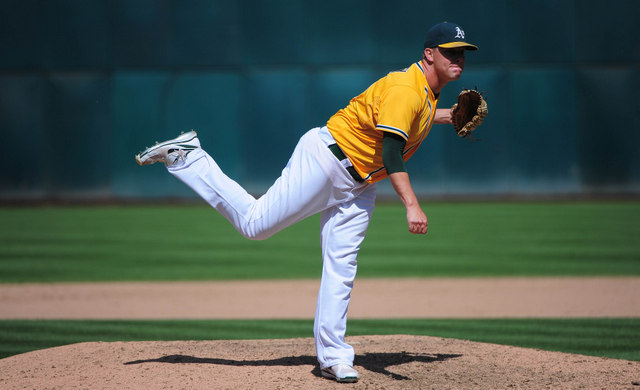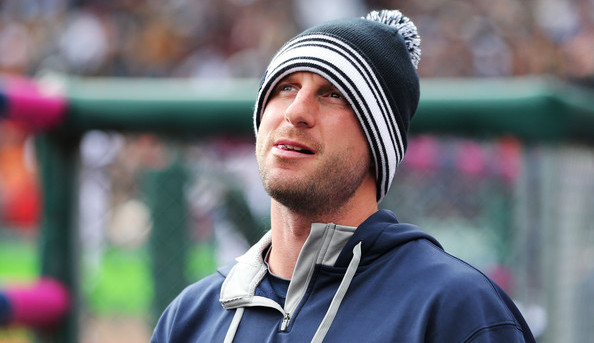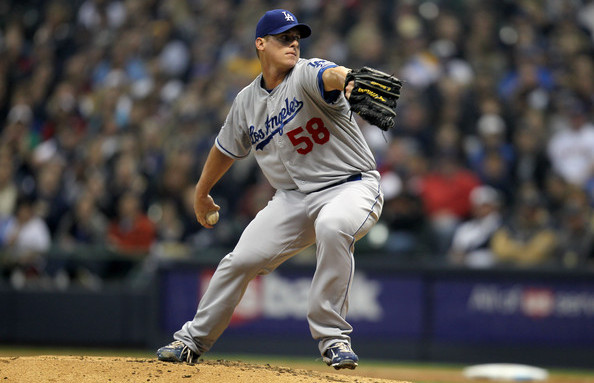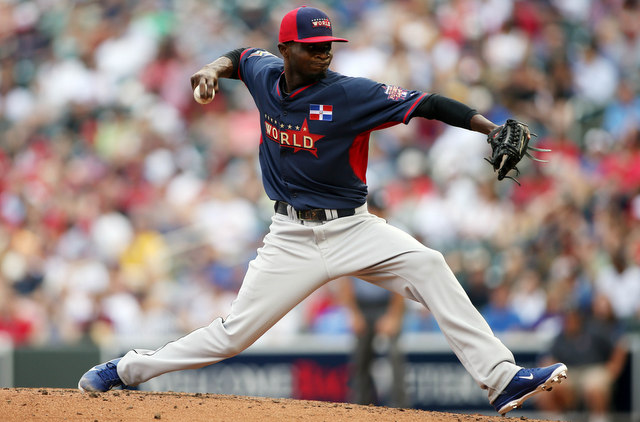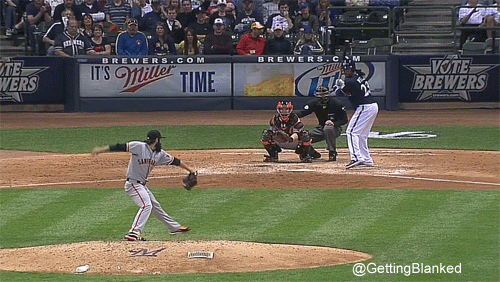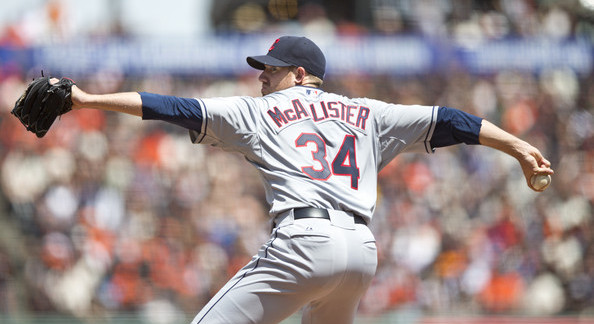
Travis asks: Zach McAllister throws hard and did well in a short stint in relief with Cleveland. If they don’t believe in him anymore, could the Yankees take a shot at hoping he is a failed starter who can be a weapon out of the bullpen?
The 27-year-old McAllister was New York’s third round pick in their tremendously productive 2006 draft class, though they traded him to the Indians as the player to be named later for Austin Kearns at the 2010 deadline. McAllister has been an up-and-down arm with the Tribe the last four years, pitching to a 4.38 ERA (3.93 FIP) in 363.1 big league innings, almost all as a starter.
McAllister really struggled in the rotation this year, posting a 5.67 ERA (3.80 FIP) with mediocre strikeout (7.40 K/9 and 18.5 K%) and walk (3.21 BB/9 and 8.0 BB%) rates. Cleveland stuck him in the bullpen late in the season and he was much better, pitching to a 2.77 ERA (1.44 FIP) with excellent strikeout (9.69 K/9 and 26.9 K%) and walk (1.38 BB/9 and 3.9 BB%) numbers in 13 innings, so small sample alert. His ground ball rate (42.1% overall) was about the same in both roles.
I don’t remember where I saw it, but a few years ago I read an article detailing traits that helped identify middling starters who would be good bullpen candidates. I don’t remember all of the traits, but I do remember one of them was effectiveness early in starts — the first time through the order, etc. — before a big drop off later on. Here’s how McAllister has done each time through the order and within his first 25 pitches of a start throughout his career (via Baseball Reference):
| Split | PA | R | H | 2B | 3B | HR | BB | SO | OPS+ | |||||||
|---|---|---|---|---|---|---|---|---|---|---|---|---|---|---|---|---|
| 1st PA in G, as SP | 585 | 42 | 117 | 28 | 3 | 11 | 39 | 127 | 3.26 | .217 | .271 | .341 | .612 | .262 | 62 | |
| 2nd PA in G, as SP | 562 | 85 | 148 | 42 | 2 | 10 | 50 | 93 | 1.86 | .295 | .357 | .447 | .804 | .341 | 113 | |
| 3rd PA in G, as SP | 374 | 64 | 107 | 26 | 1 | 18 | 30 | 64 | 2.13 | .316 | .374 | .558 | .932 | .344 | 144 | |
| 4th+ PA in G, as SP | 10 | 1 | 4 | 0 | 0 | 1 | 1 | 1 | 1.00 | .444 | .500 | .778 | 1.278 | .429 | 233 |
| Split | PA | R | H | 2B | 3B | HR | BB | SO | OPS+ | |||||||
|---|---|---|---|---|---|---|---|---|---|---|---|---|---|---|---|---|
| Pitch 1-25 | 423 | 28 | 88 | 21 | 3 | 7 | 18 | 93 | 5.17 | .220 | .255 | .340 | .595 | .267 | 57 | |
| Pitch 26-50 | 428 | 52 | 98 | 27 | 0 | 7 | 46 | 81 | 1.76 | .260 | .338 | .387 | .725 | .312 | 93 | |
| Pitch 51-75 | 389 | 60 | 109 | 26 | 3 | 8 | 33 | 60 | 1.82 | .314 | .371 | .476 | .847 | .354 | 124 | |
| Pitch 76-100 | 298 | 52 | 83 | 19 | 0 | 17 | 20 | 54 | 2.70 | .303 | .356 | .558 | .914 | .324 | 138 | |
| Pitch 101+ | 45 | 2 | 11 | 4 | 0 | 1 | 5 | 11 | 2.20 | .275 | .356 | .450 | .806 | .357 | 113 |
Those are some pretty significant splits, no? McAllister has been considerably better the first time through the order and within his first 25 pitches throughout his career. It’s a big, big drop off the second time through the lineup and after pitch 25. That suggests he might be best used as a short reliever who doesn’t have to turn the lineup over multiple times.
Furthermore, while McAllister does throw four pitches, he is very fastball heavy. He threw 64.5% four-seam fastballs back in 2011, and that has gradually increased to 69.7% in 2012, 73.1% in 2013, and 73.6% in 2014. McAllister’s thrown his changeup, cutter, and slider roughly 8-10% of the time each over the years. Unsurprisingly, his velocity ticked up noticeably in relief this past September (via Brooks Baseball):
During his 13 innings in relief, McAllister scrapped his changeup and cutter and became a fastball-slider pitcher. The swing-and-miss rates for his fastball and slider went from ~8% and ~10% as a starter to ~11% and ~27% as a reliever, respectively. That’s a really big jump. But, of course, we are talking about only 13 innings, so we have to take it with a grain of salt. The velocity uptick definitely makes sense though, and there’s a pretty strong correlation between velocity and whiffs.
McAllister hasn’t showed a platoon split in the big leagues — .332 wOBA and 3.96 FIP against lefties, .329 wOBA and 3.90 FIP against righties — so he’s not someone who has to be hidden against lefties. (I’m pretty sure one of the traits that suggested a starter would be better off in the bullpen was a big platoon split.) If he were to go straight fastball-slider as a reliever, his platoon split might grow because sliders are typically reserved for same-side hitters. It’s not guaranteed to happen, but it could.
The increased effectiveness early in outings, the uptick in velocity, and his performance as a reliever in September (albeit in a small sample) all suggest McAllister would be much better off in the bullpen going forward. It would be better for him — above-average reliever pays better than disposable back-end starter, or at least it pays comparably with more job security — and better for his team as well. Now here’s a really fun comparison:
| ERA | FIP | K% | BB% | GB% | HR/FB% | |
|---|---|---|---|---|---|---|
| Wade Davis as a SP |
4.57 | 4.49 | 16.1 | 8.5 | 38.2 | 9.7 |
| McAllister as a SP | 4.44 | 4.03 | 18.6 | 7.8 | 39.6 | 9.1 |
Those two pitchers are really similar! Davis moved into the bullpen and became an absolute monster, basically a Dellin Betances who doesn’t give up homers. (Davis allowed zero homers in 2014.) That little table doesn’t mean McAllister will turn into an otherworldly reliever because Davis did, I just thought it was interesting. Some guys are just better off in the bullpen like Davis and Betances. McAllister might be one of those guys.
Based on all of this, I really like the idea of the Yankees bringing McAllister back and sticking him in relief. He is out of minor league options but New York does have two open bullpen spots, so there’s room on the roster for him. McAllister will be in his final pre-arbitration year in 2015, so he’ll be cheap, and he’ll remain under team control as an arbitration-eligible player through 2018. Obviously the team knows him too, so there’s some familiarity there.
The Indians have plenty of starters — McAllister is eighth on their rotation depth chart — so he might be considered expendable. I’m not quite sure what it would take to acquire him, but Ross Detwiler cost the Rangers two okay prospects a few weeks ago, guys in the 20-30 range on a prospect list. It’s not a perfect comparison — Detwiler’s a year away from free agency and was a former top prospect (sixth overall in 2007) — but it’s what we have. I’m very intrigued by McAllister as a reliever. If all it takes is two 20-30 range prospects to get him, I’d pull the trigger and see what he can do in a one-inning role.
